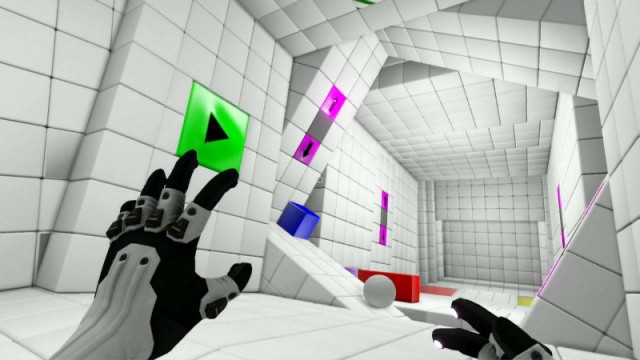Intriguing story; great aesthetic; clever and challenging puzzles
Unforgivable glitches; some questionable game physics; little replay value
Q.U.B.E. has already been available on PC and Mac for a number of years. Developed by Toxic Games, this clever first-person puzzler was initially a student project made by the three founding members: Dave Hall, Daniel Da Rocha, and Johnathan Savery. With a lot of positive feedback upon their graduation and a little help from the aptly named organization Indie Fund, Q.U.B.E. debuted on PC in 2011 and has since been ported to multiple consoles, including Wii U.
Unlike the 2011 release, the Wii U port is the Director’s Cut, an overhauled version of the PC original, featuring a brand new musical score as well as a story element that serves to make sense of the game’s world (or in this case, cube!)
You start as a nameless protagonist, slowly composing yourself as you come around after losing consciousness. You are inside a mysterious object and are soon given some vague information from a women’s voice on your intercom– Commander Novak, an astronaut aboard the international space station, helping to relay information from Mission Control back on earth. She’s your guide and only friend whilst out there in space… or is she?
Novak informs you that you are inside a cubed structure that is set on a collision course with Earth. It’s up to you to dismantle the cube from the inside before this happens, equipped with nothing but the space suit you are wearing and a special pair of gloves. These gloves (strangely reminiscent of Nintendo’s once iconic Power Glove!) allow you to interact with specific colored cubes that litter your environment as you progress from room to room. The function of each of these colored cubes varies, from extending and retracting, serving as a catapult, or rotating certain sections of the room. Although this may start simple enough, Q.U.B.E.’s difficulty curve soon turns skyward, and you soon have to deal with multiple functioning cubes all providing help or sometimes hindrance to the game’s core puzzles.
Q.U.B.E. offers nothing in the way of a tutorial, leaving the player to figure things out for themselves, immersing you in the sterile and often claustrophobic environment. This is where the game excels thanks to a haunting musical score and a storyline that is drip fed to you, creating a sense mystery and intrigue from the outset that never really falters throughout the five or six hours it takes to complete the main campaign. If you were trapped in a giant cube and needed to get out, this is what it would be like!

The game also has a simplistic yet wonderful aesthetic, some would say taking direct influence from the likes of Valve’s epic puzzler, Portal. Although there are obvious similarities, Q.U.B.E. does offer originality by way of its unique and mind-bending puzzles that constantly evolve, keeping you on your toes and holding your attention.
Unfortunately, the game does have its flaws. Although most puzzles are challenging and well-paced, a select few are frustratingly tedious. The puzzles involving the use of magnetism are a particular low point, relying more so on luck to complete them rather than skill or intelligence.
A number of glitches in the game also remove some of the sheen from an otherwise decent puzzler. Sound effects that constantly cut out and objects that sometimes have a mind of their own and slide out of place for no reason are development bugs that should really have been rectified before release. As I mentioned at the start of the review, Q.U.B.E. is almost four years old now and any glitches detrimental to gameplay should have been resolved long ago.
If I were to be extra picky, then it would have been nice to see use of Wii U’s touchscreen; however, this can be forgiven when reminded that this is an indie title after all, made by a relatively small developer new to the game, so to speak.
All in all, I enjoyed my time with Q.U.B.E. I’m not one for puzzle games usually, but I found I wanted to carry on and progress through its intriguing story, regardless of how frustrated I got. Unfortunately, there is little replay value here. Once the campaign is complete you are left with an additional ten levels with a simple beat-the-clock scenario which, whilst fun for a while, lack anything other than beating your previous score to entice you back. An enjoyable game with some great ideas, unfortunately marred by some unforgivable glitches and gameplay physics that don’t give it that final polish needed to keep up with the big boys.
Nintendojo was provided a copy of this game for review by a third party, though that does not affect our recommendation. For every review, Nintendojo uses a standard criteria.




 ShareThis
ShareThis







Never heard of this, but for some reason I am intrigued. I’ll wait for a sale, though.
Are the gliches exclusive to the Wii U, or should I just pick up the Steam version?
Unfortunately, I haven’t played the Steam version to make any comparison. Some of the reviews online suggest it suffers from a number of bugs so I’m assuming these will be the same as the console ports. I’d still recommend giving it a look if you’re a fan of these type of games.